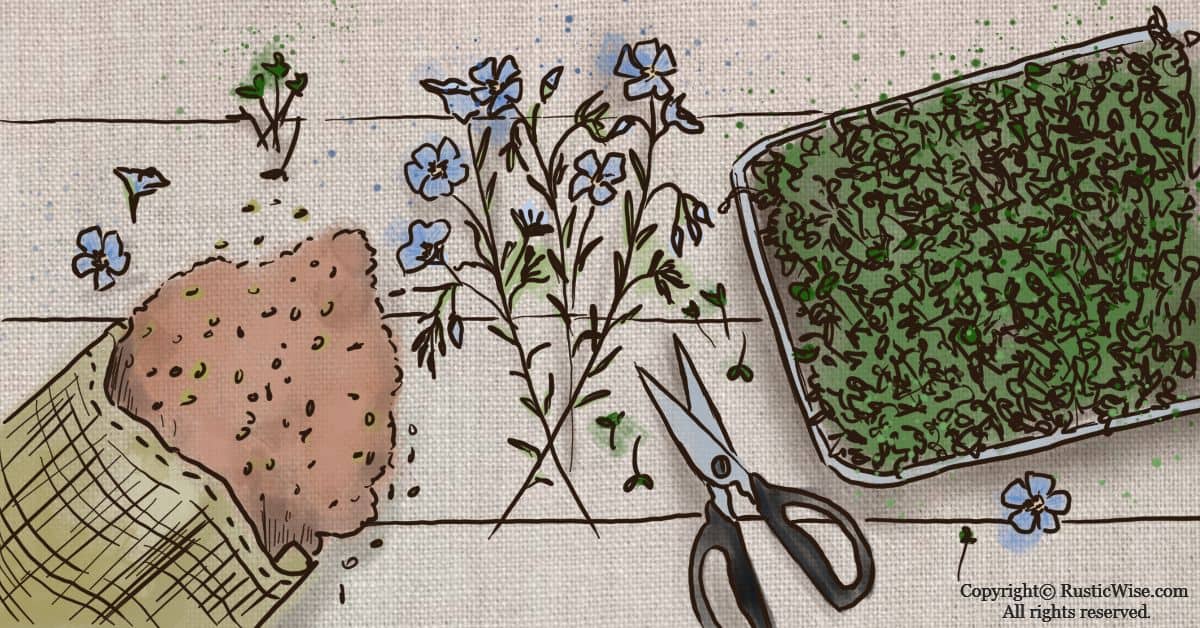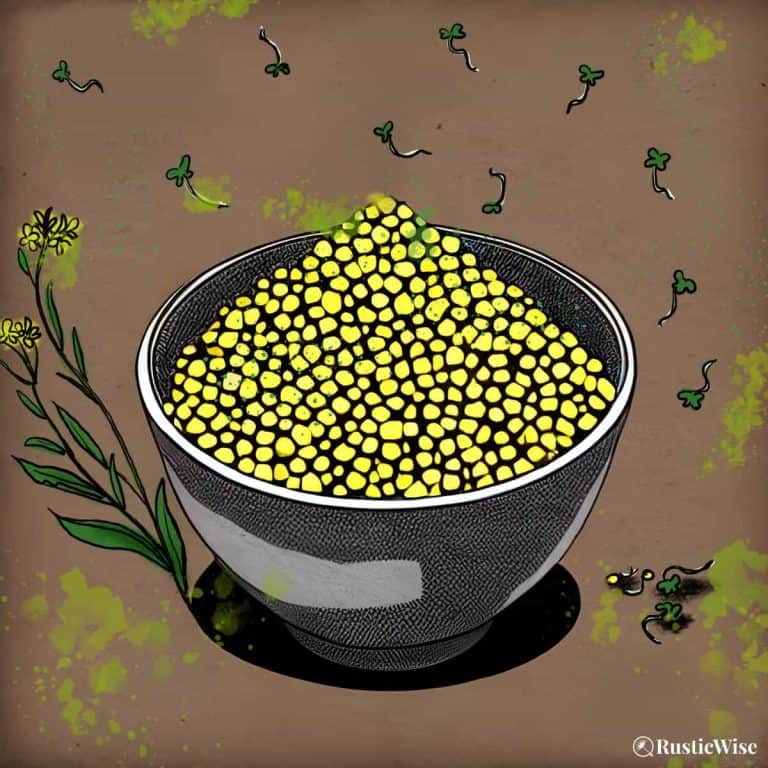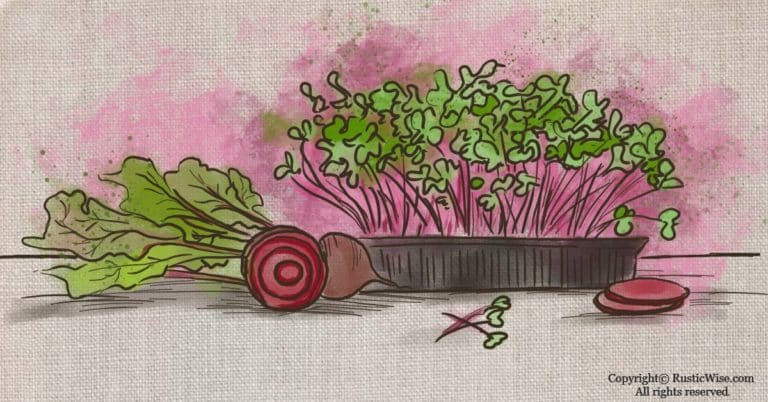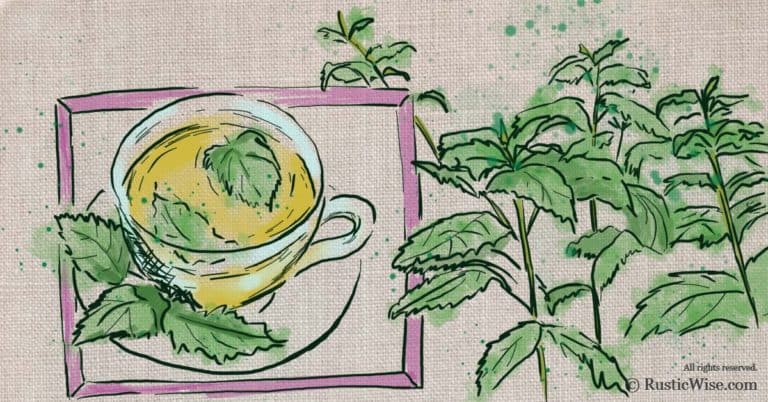The Benefits of Flax Microgreens and How To Grow Your Own
If you’re looking for a healthy food that provides your body with the nutrients it needs, then look no further than flax microgreens. Flax, also known as linseed, is an herb that has been cultivated for centuries mainly for its seeds. Flax microgreens are rich in protein and omega-3s. We’ll take a closer look at the health benefits of flax microgreens, how microgreens can boost your health, and how to grow them at home.
Maybe you’ve heard about the numerous health benefits of flax and want to try them out for yourself. You’ve probably eaten flax seeds in breads or cereals. Maybe you use flax seeds at home and throw them into smoothies or sprinkle them on salads or cereal.
If you’re on the lookout to add more greens to your diet—good news! Now you can also include flax microgreens into your rotation of healthy greens. Flax microgreens are a tasty way to get many essential vitamins and nutrients on a daily basis.
Microgreens are small plants grown from seeds and harvested before they’ve become fully mature. They’re typically consumed raw in salads or on sandwiches and wraps.
Read on to learn about the health benefits of flax microgreens and how you can grow your own.
What are flax microgreens?
If you’re new to the world of home sprouting and microgreens, welcome! Microgreens are tiny plants grown from seeds and harvested when only a couple inches tall. They contain the cotyledons (seed leaves) of the plants which are packed with vitamins and nutrients.
Microgreens are grown in soil or a growing medium such as coconut coir, and harvested just above the soil line. While many people use the terms “sprouts” and “microgreens” interchangeably, there are some key differences. We’ve written an article outlining the differences between sprouts and microgreens if you want to read up on this.
Sprouts are eaten whole (root, shoot, and stem). At home, many people sprout seeds in glass mason jars, or tray sprouters. You don’t need any soil to sprout.
So what exactly are flax microgreens? Simply put, flax microgreens are tiny plants grown from flaxseeds. The seeds are densely sown on a growing medium, and they’re harvested when the cotyledons have fully emerged, or when a one or two “true leaves” appear. These tiny greens have a vibrant green color and a mild, slightly nutty flavor.
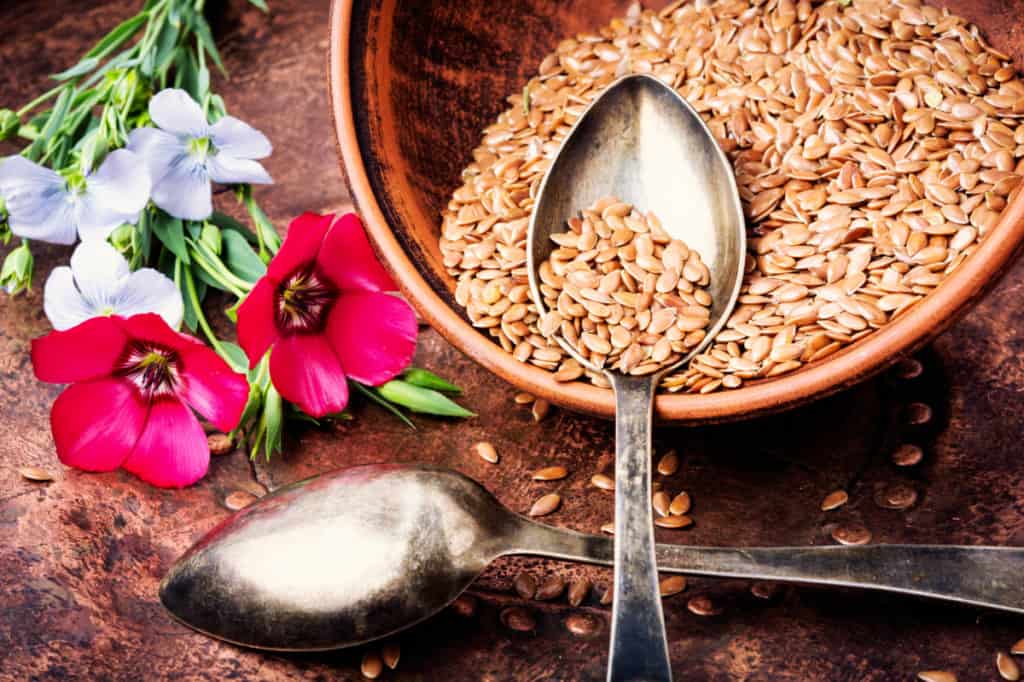
Health benefits of flax microgreens
Walking down the health food aisle at the grocery store, you may have noticed a variety of seeds including flax, chia, or hemp hearts. Let’s take a closer look at the nutritional content of flax seeds.
Flax seeds are a nutritional powerhouse. Lignans are a form of phytoestrogen which is a natural plant nutrient similar to estrogen, the female hormone. In fact, flaxseeds contain 75–800 times more lignans than other plant foods.
As lignans have powerful antioxidant properties, some studies show that flaxseeds may protect against some forms of cancer including breast cancer, colon cancer, and prostate cancer. The lignans play a role in blocking the spread of tumor cells.
However, like all good things, it’s important to eat flax seeds in moderation. As flax seeds have such a concentrated form of lignans (phytoestrogen), there is a risk of this nutrient interfering with breast cancer treatment. Speak to a health care professional before introducing flaxseeds into your diet.
Oncology Nutrition recommends limiting the amount of ground flaxseeds consumed in one day to two to three tablespoons per day.
Flax is also rich in omega-fatty acids (specifically plant-based ALAs, or alpha-linolenic acid), fiber, and contains all nine essential amino acids that your body needs on an everyday basis.
According to data from the USDA, 1 tablespoon (10 grams) of whole flaxseeds has 55 calories. Where the calories come from:
- 13% protein
- 67% fat
- 20% carbs
Now some of you might panic at seeing such a high fat content. Don’t fret. The majority of fats contained in flax are healthy fats from omega-3s.
| Flaxseeds, whole (1 tablespoon/10 grams) | |
|---|---|
| Calories | 55 |
| Fiber | 2.8 grams |
| Fat | 4.3 grams |
| Protein | 1.9 grams |
| Carbs | 3 grams |
| Copper | 14% of the Daily Value |
| Manganese | 11% of the DV |
| Magnesium | 10% of the DV |
| Phosphorous | 5% of the DV |
| Selenium | 5% of the DV |
| Zinc | 4% of the DV |
| Iron | 3% of the DV |
| Calcium | 2% of the DV |
| Potassium | 2% of the DV |
| Omega-3s | 147% of the Adequate Intake (AI) |
| Omega-6s | 4% of the AI |
Now let’s take a look at how some of these minerals and nutrients benefit our health.
- Dietary fiber: Foods rich in fiber promote a healthy digestive system. Flax contains both soluble and insoluble fiber.
- Omega-3 fatty acids: Omega-3 fatty acids are important for heart health, as they reduce triglyceride levels in the body. This plant is packed with alpha-linolenic acid (ALA), an omega-three fatty acid which has been shown to decrease inflammation in the body. Omega-3s help to improve cardiovascular health by decreasing the risk of blood clots, keeping the lining of the arteries free of plaque. Omega-3s may also help to improve levels of “good” (HDL) cholesterol.
- Protein: Those that are on plant-based diets will like that flax contains a fair amount of protein. Protein helps you feel full for longer periods of time, and it’s also important in muscle growth.
- Copper: Plays a vital role in metabolizing iron and promotes an overall healthy immune system. Copper also helps to create new red blood cells.
- Iron: Iron helps transport oxygen to all parts of the body and is a vital mineral that helps produce energy.
- Phosphorous: Phosphorus is important for the healthy functioning of all cells in your body because it helps with cell growth and repair. This mineral also works to maintain an ideal balance of fluids in your body which aids digestion, muscle function, and bone health.
- Manganese: Plays an important role in building healthy bones. It also helps to process amino acids, cholesterol, and carbs.
- Magnesium: An important nutrient for building strong bones and teeth. Used together with calcium for healthy blood clotting, muscle contraction, and overall blood pressure regulation.
- Selenium: Selenium promotes a strong immune system. As well, it as acts as a powerful antioxidant and helps regulate the thyroid’s hormonal activity.
Did you know that the process of sprouting seeds make them easier to digest? Sprouting helps to break down the hard outer layer of the seed which makes the nutrients and vitamins within the seeds easier to absorb into our bodies.
A 2012 study by the U.S. Department of Agriculture (USDA) and researchers from the University of Maryland analyzed 25 varieties of commercially available microgreens. They found that on average, microgreens contain about five times more nutrients and vitamins than the mature leaves of the same plant.
So now that you know about the health benefits of flax, are you ready to start growing your own flax microgreens?
Tip: Flax seeds and flax microgreens are a rich source of healthy omega-3s and protein—perfect especially if you’re on a plant-based diet.
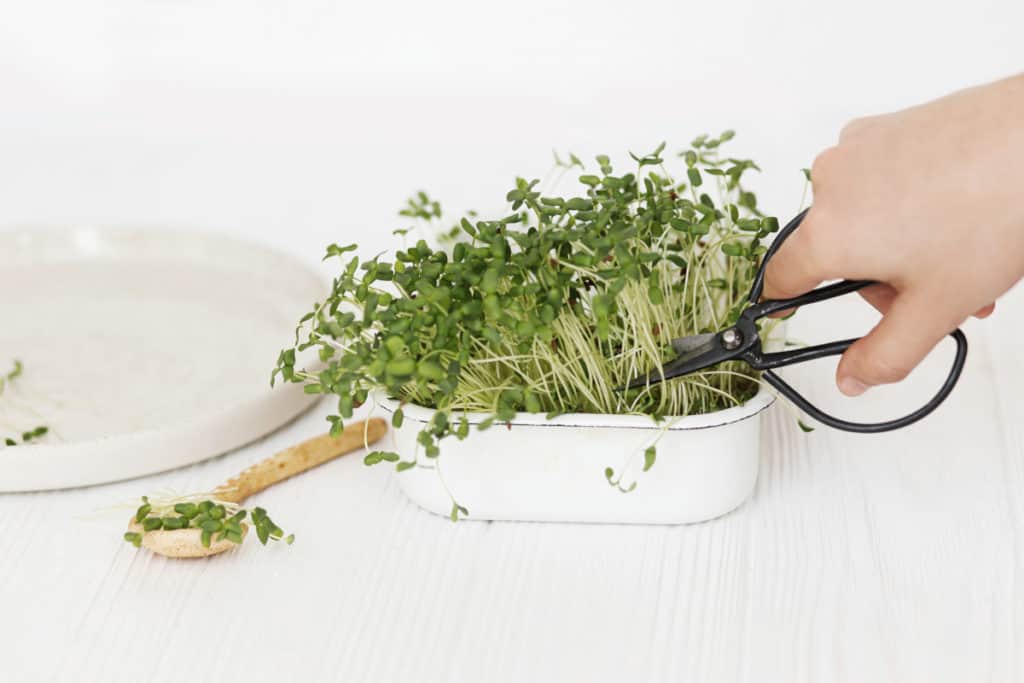
Credit: Deposit Photos
How to grow your own flax microgreens
First things first. When you’re growing flax microgreens, it’s important to know that flax, like chia, is a mucilaginous, or gelatinous seed. That means that when these tiny seeds come in contact with water, they form a gel-like substance around each seed.
Keep this in mind when you’re thinking about where to store your seeds and how much water they will need throughout the germination process, which usually takes around three or four days.
While there are different types of flax seeds, the most common type for growing microgreens are golden-brown. They are really lovely seeds to behold. You can buy them online from the Sprout People, or your local specialty seed store. Seeds should be untreated, designed for high-germination, and preferably organic.
Let’s gather together a few supplies!
You’ll need:
- A growing tray and cover: Common sizes are 5 X 5, 10 X 10, or 10 X 20. You can also use a shallow container you have around the house if you don’t have a grow tray handy. Just remember to poke a few drainage holes.
- Growing medium: Organic potting mix, or a soilless growing medium such as coconut coir.
- Flax seeds: You’ll need about 1–2 teaspoons for a 5 X 5 tray, or 2–4 tablespoons for a 10 X 20 tray.
- Water mister
There’s no need to soak flax seeds for growing microgreens.
Ready to harvest: 5–14 days
- Prepare your growing tray and growing medium. Starting with a clean growing tray, fill it with 1–2 inches (2.5–5.1 centimeters) of potting mix. Remove any debris, or rocks from the growing medium. Lightly compress the growing medium with your hands, or a small piece of cardboard. Use your water mister to thoroughly moisten the medium.
- Seed. Sprinkle the flax seeds onto your growing tray, evenly distributing them across the surface. You can use a spoon or measuring cup to do this. Since flax seeds are mucilaginous, you may notice that they develop a gel-like sac around each seed upon contact with water on the growing medium.
- Cover and place in the dark. Place your tray cover over the seeds. This is the start of the germination phase. If your growing medium has been thoroughly moistened, there’s no need to water again until you see signs of growth. Place your tray of microgreens at room temperature away from sunlight.
- Watch for germination. It usually takes around 3–4 days to see signs of germination. Once you see this, you can use your water mister to gently water the soil as needed. Take care not to crush the delicate stems and avoid spraying directly onto the greens. This may be every day, or every other day. Once the flax greens have shed most of their hulls and show steady growth, it’s time to bring them into the light. Don’t be alarmed if you see tiny root hairs develop on your flax seeds. This is normal. Check out our post on the difference between root hairs vs. mold.
- Remove cover and give it light. Now that your flax microgreens are growing steadily, it’s time to give them some light! Place your tray near a window (away from direct sunlight). If you’re planning on growing your flax microgreens until they develop full true leaves, you’ll need to give them more light.
- Bottom water. Continue to keep the growing medium moist. To prevent the fragile stems from getting crushed, try bottom watering if your growing tray has drainage holes. This is as simple as placing your tray of greens into another clean tray filled with about 1/2-inch of clean water and letting them get a drink for several minutes.
- Harvest. The best way to harvest microgreens is to taste them throughout the growing process. Harvest when you think they taste best. This is typically some point between when the cotyledons have fully emerged, or when one or two sets of true leaves are developed. For flax microgreens this is between 5–14 days. Take a pair of sharp scissors or a knife and snip just about the soil line.
Microgreens keep up to one week in the fridge. Give them a quick rinse right before eating.
Can you grow flax sprouts?
If you’re familiar with home sprouting, many people sprout using a glass mason jar. However, flax sprouts can’t be sprouted in this manner because they’re mucilaginous. If you try sprouting flax in a jar, you’ll end up with a gooey mess.
However, you can sprout flax seeds similar to how you would other mucilaginous seeds like chia seeds, for example. Check out our article on sprouting chia seeds.
All you need is a clean, unglazed terracotta dish, organic flax seeds, and a water mister.
👉Check out a more in-depth look at sprouting flax at home.
How to use flax microgreens
Flax microgreens have a mild, slightly nutty flavor that can be used in a variety of dishes.
They’re best served raw. Add flax microgreens to salads, soups, sandwiches and smoothies for an extra nutritional boost. They’re high in protein with all nine essential amino acids which makes them the perfect post workout snack!
Check out our post on microgreen smoothie recipes. Throw in a handful or two of flax microgreens into a smoothie for a tasty and nutritious drink.
Related questions
Are microgreens safe to eat?
Microgreens are generally considered safer to eat than sprouts. Microgreens are grown much like other vegetables (in soil, or a similar growing medium).
You might have heard of foodborne illnesses linked to sprouts. Most sprouts are grown in dark and humid environments that can be breeding grounds for harmful pathogens if not properly managed. The U.S. Food and Drug Administration (FDA) attributed these outbreaks to contaminated seeds. Since then the FDA has drafted safer legislation for commercial sprout growers.
With proper safety precautions for both homegrown microgreens and sprouts, you can minimize the risk of developing foodborne illnesses. Check out our posts on sprout safety and a differences between sprouts and microgreens.
Are flaxseeds good for weight loss?
Flaxseeds contain lignans which are natural substances that are may help in weight loss. Many people use ground flaxseeds to make weight loss drinks, but why not use flax microgreens? Flax microgreens are nutrient-rich and low in calories making them a healthy part of a weight-loss diet. Its high protein content also helps keep you feeling satiated and full.
👉 If you like this post, see our Complete Guide to Growing Microgreens at Home. 🌱
Would you like more timeless tips via email?
Fun tips to help you live an independent, self-sustaining lifestyle. Opt-out at any time.


References:
- Magee, Elaine, “The Benefits of Flaxseed,” WebMD. Accessed April 2021.
- Oncology Nutrition, Flaxseeds and Breast Cancer, https://www.oncologynutrition.org/erfc/healthy-nutrition-now/foods/flaxseeds-and-breast-cancer. Accessed April 2021.
- My Food Data (USDA), Flax Seeds, https://tools.myfooddata.com/nutrition-facts/169414/wt1/1. Accessed April 2021.
- Harvard Health, Listing of vitamins, https://www.health.harvard.edu/staying-healthy/listing_of_vitamins. Accessed April 2021.
- Cleveland Clinic, Omega-3 Fatty Acids, https://my.clevelandclinic.org/health/articles/17290-omega-3-fatty-acids. Accessed April 2021.
- Lester, Gene & Xiao, Zhenlei & Luo, Yaguang & Wang, Qin. (2013). Microgreens: Assessment of Nutrient Concentrations. Journal of Agricultural and Food Chemistry. Accessed April 2021. https://www.researchgate.net/publication/267354000_Microgreens_Assessment_of_Nutrient_Concentrations
- Sprout People, Flax Micro-Greens, https://sproutpeople.org/flax-micro-greens/. Accessed April 2021.

Author: Josh Tesolin
Josh is co-founder of RusticWise. When he’s not tinkering in the garden, or fixing something around the house, you can find him working on a vast array of random side projects.

